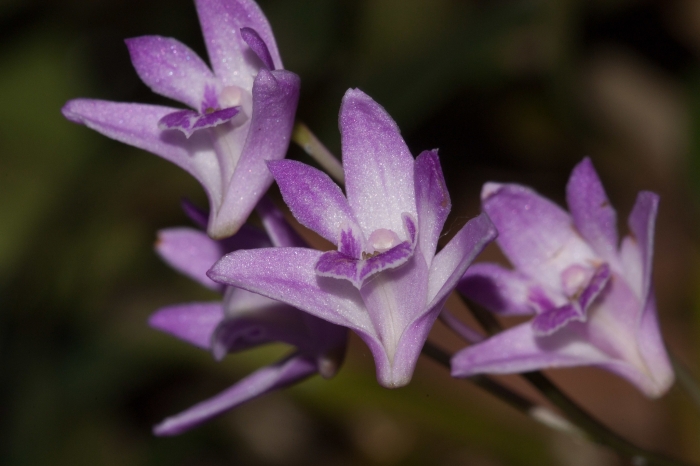Pink Rock Orchid
(Dendrobium kingianum)
Pink Rock Orchid (Dendrobium kingianum)
/
/

Rolf Lawrenz
CC BY 4.0
Image By:
Rolf Lawrenz
Recorded By:
Copyright:
CC BY 4.0
Copyright Notice:
Photo by: Rolf Lawrenz | License Type: CC BY 4.0 | License URL: http://creativecommons.org/licenses/by/4.0/ | Rights Holder: Rolf Lawrenz | Publisher: iNaturalist | Date Created: 2006-09-18T12:02:16-07:00 |





















Estimated Native Range
Summary
Dendrobium kingianum, commonly known as the pink rock orchid, is a perennial herbaceous plant endemic to eastern Australia, particularly from the Hunter River in New South Wales to Rockhampton in Queensland. It is a lithophyte, typically found growing on rocks and occasionally as an epiphyte on trees. This orchid has thin, spreading leaves and produces spikes of fragrant, pink flowers that are quite showy, blooming from late summer to early autumn (August to October). The pink rock orchid reaches a modest size, making it suitable for container growing.
The pink rock orchid is favored for its ease of cultivation and its ability to thrive in a range of conditions, from cool to warm environments. It is often grown mounted on pieces of bark or rocks to mimic its natural habitat. In cultivation, it requires a well-draining potting medium, moderate watering with a drier winter rest period, and bright light with some direct sun. It is a popular choice for rockeries, greenhouses, and as a houseplant. While it is relatively pest-free, it can sometimes be affected by scale insects or fungal diseases if overwatered or if air circulation is poor.CC BY-SA 4.0
The pink rock orchid is favored for its ease of cultivation and its ability to thrive in a range of conditions, from cool to warm environments. It is often grown mounted on pieces of bark or rocks to mimic its natural habitat. In cultivation, it requires a well-draining potting medium, moderate watering with a drier winter rest period, and bright light with some direct sun. It is a popular choice for rockeries, greenhouses, and as a houseplant. While it is relatively pest-free, it can sometimes be affected by scale insects or fungal diseases if overwatered or if air circulation is poor.CC BY-SA 4.0
Plant Description
- Plant Type: Herb, Bulb
- Height: 0.5-1 feet
- Width: 0.5-1 feet
- Growth Rate: Moderate, Rapid
- Flower Color: Pink
- Flowering Season: Summer, Fall
- Leaf Retention: Evergreen
Growth Requirements
- Sun: Part Shade
- Water: Medium
- Drainage: Fast, Medium
Common Uses
Butterfly Garden, Low Maintenance, Potted Plant, Rock Garden
Natural Habitat
Native to rocky outcrops and cliff faces in open forests and woodlands, often adjacent to forest creeks
Other Names
Common Names: Captain King’s Dendrobium
Scientific Names: , Dendrobium kingianum, Callista kingiana, Dendrobium kingianum, Dendrocoryne kingianum, Thelychiton kingianus, Tropilis kingiana,
GBIF Accepted Name: